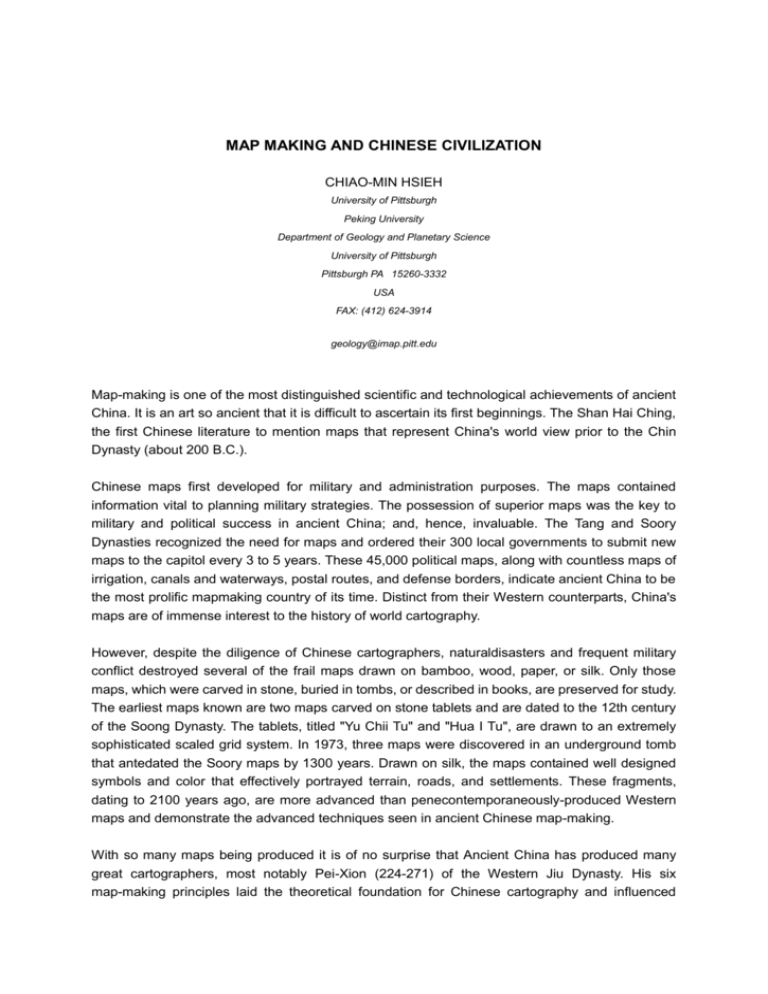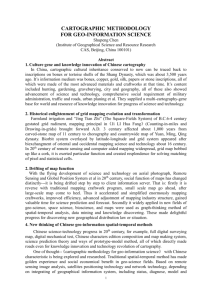论文编号:
advertisement

MAP MAKING AND CHINESE CIVILIZATION CHIAO-MIN HSIEH University of Pittsburgh Peking University Department of Geology and Planetary Science University of Pittsburgh Pittsburgh PA 15260-3332 USA FAX: (412) 624-3914 geology@imap.pitt.edu Map-making is one of the most distinguished scientific and technological achievements of ancient China. It is an art so ancient that it is difficult to ascertain its first beginnings. The Shan Hai Ching, the first Chinese literature to mention maps that represent China's world view prior to the Chin Dynasty (about 200 B.C.). Chinese maps first developed for military and administration purposes. The maps contained information vital to planning military strategies. The possession of superior maps was the key to military and political success in ancient China; and, hence, invaluable. The Tang and Soory Dynasties recognized the need for maps and ordered their 300 local governments to submit new maps to the capitol every 3 to 5 years. These 45,000 political maps, along with countless maps of irrigation, canals and waterways, postal routes, and defense borders, indicate ancient China to be the most prolific mapmaking country of its time. Distinct from their Western counterparts, China's maps are of immense interest to the history of world cartography. However, despite the diligence of Chinese cartographers, naturaldisasters and frequent military conflict destroyed several of the frail maps drawn on bamboo, wood, paper, or silk. Only those maps, which were carved in stone, buried in tombs, or described in books, are preserved for study. The earliest maps known are two maps carved on stone tablets and are dated to the 12th century of the Soong Dynasty. The tablets, titled "Yu Chii Tu" and "Hua I Tu", are drawn to an extremely sophisticated scaled grid system. In 1973, three maps were discovered in an underground tomb that antedated the Soory maps by 1300 years. Drawn on silk, the maps contained well designed symbols and color that effectively portrayed terrain, roads, and settlements. These fragments, dating to 2100 years ago, are more advanced than penecontemporaneously-produced Western maps and demonstrate the advanced techniques seen in ancient Chinese map-making. With so many maps being produced it is of no surprise that Ancient China has produced many great cartographers, most notably Pei-Xion (224-271) of the Western Jiu Dynasty. His six map-making principles laid the theoretical foundation for Chinese cartography and influenced Eastern map-making for thousands of years. During Europe's Middle Ages, Chinese cartographers such as Chia Tan (730-805), Chu Sen-peu (1273-1337), Lo Hung-Hsien (1504-1564) continued to advance mapping techniques. During the 15th century, Chen Ho, the most illustrious Chinese explorer, led seven expeditions to the Pacific and Indian Oceans, eighty years before DeGamas. The map that is believed to have been used by Cheng Ho is contained within the "Wu pei chih", dated to 1621. Cheng's map remains one of the most interesting cartographic records of Southeast, Asia and India. Chinese cartography entered a new era with the arrival of Italian Jurist Matto Ricci in 1582. Ricci introduced the Chinese to European techniques to project longitude and latitude onto large-scale maps. Great changes continued to occur during the Ching Dynasty, especially during the reigns of Kangai and Qianlong. Employing western mapping methods, Kangsi launched a ten-year, trigonometric ground survey of his empire. In 1761, the Qianlong emperor oversaw the completion of a map that covered an area bounded by the Arctic and Indian Oceans and the Mediterranean and Red Seas. At the time, it was the most comprehensive map of the Asian continent. These two maps laid the foundation for surveying and mapping within modern China.











